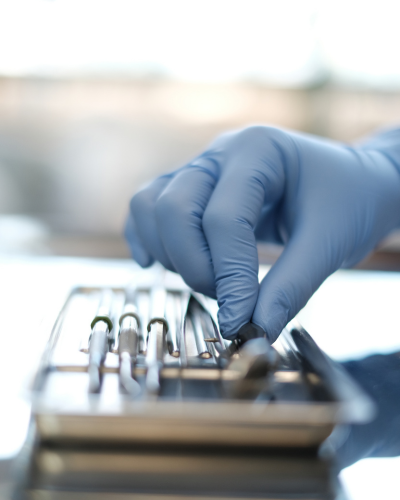
Cleaning & Processing
Recommended Procedures for Care, Maintenance and Sterilization of Stainless Steel Instruments.
Unless alternative instructions are supplied with individual products, these instructions apply to all stainless steel instruments supplied by Pedicare. All products are supplied unsterile unless specified otherwise. The use of all instruments is limited to qualified personnel.
New Instrument Care
After removing from packaging, instruments should be cleaned and sterilized before use. During cleaning and sterilization cycles, do not mix dissimilar metal instruments. Keep stainless steel/chromium plated/silver plated instruments etc. separate and do not process in the same cycle; otherwise corrosion or staining may occur on the stainless steel instruments. . The majority of instruments that contain joints or metal to metal contact are not pre-lubricated. We recommend after removal from packaging the instruments are rinsed, cleaned and lubricated prior to sterilization.
We do not recommend “WD40”, sewing machine oil or other industrial lubricants. A specially formulated instrument lubricant by Miltex, is available from Pedicare that is formulated for stainless steel instruments.
Holding / Presoak
Always wear safety protection for eyes, hands and clothing.
Never hold “dirty” instruments in a dry container. Doing so allows blood and debris to dry onto instrument surfaces and may contribute to corrosion of the surface. If the ability to clean instruments is not readily available then instruments are to be held in a neutral pH holding / presoak enzymatic solution after patient use but before actual cleaning. Do not allow the holding solution to dry on the instruments. Instruments must be covered at all times in the presoak / holding enzyme solution.
Rinsing
After removal from new packaging, immediately after use or after immersion in a holding presoak - the instruments should be washed/rinsed with warm running water, preferably demineralised water. Care should be taken to remove all traces of blood or foreign debris, especially from serrations and joints.
Cleaning
Always wear safety protection for eyes, hands and clothing.
Manual cleaning is recommended. If machine washing or chemical cleaners are to be used, the manufacturer’s guidelines for cleaning instruments must be followed. A nylon bristled brush is to be used. Under no circumstance must iron wool, iron bristled brushes or abrasives to be used. Use only neutral pH 7 detergents. Low pH (acidic – less than 6 pH) detergents break down the stainless protective surface resulting in pitting and / or black staining on instruments. High pH detergents (alkaline – more than 8 pH) can cause brown stains (phosphate surface deposit). Most brown stains are not rust and are easily removed with a surgical instrument stain remover. At this stage the instruments should be carefully inspected to ensure that their working parts and functions are not impaired. Once cleaning and inspection have been completed, instruments must be dried thoroughly prior to the sterilization process. Once instruments are dry, any instruments that have joints or have metal to metal contact should then be lubricated with Miltex Instrument Lube.
Disinfection
We do not recommend this form of cleaning. You must first verify if the manufacturer allows for disinfection and then the manufacturer’s instructions on concentrations of solutions and processing times should be strictly adhered to. Some disinfectants will cause corrosion to stainless steels.
*Caution* Cleaning, rinsing, disinfection and boiling render instruments “clean”. They do not make instruments sterile.
Sterilization
Unless specified otherwise with instructions for individual products. Sterilization may be performed by autoclaving, dry heat, flash autoclaving, gamma irradiation or ethylene oxide. Always consult individual instructions as supplied with instruments or manufacturer’s respective web site. Do not allow the temperature of sterilizers/autoclaves to exceed 180 degrees centigrade, otherwise the instruments may be discoloured or their strength (temper) may be impaired.
IMPORTANT – Always sterilize instruments in their open positions. Disengage all ratchets (locks) and ensure sufficient surface of the joint is exposed to allow the sterilizing medium access to the surfaces hidden under the joint (box locks for example). If instruments are sterilized in a process where heat is involved and the instruments are left in their locked positions, the joints will crack.
After sterilization the instruments are to be allowed to cool and fully air dry before use. Whichever process is used, adhere strictly to manufacturers sterilization instructions. Wherever water is used in sterilization procedures, e.g. in “steam autoclaving”, salt free demineralized water is to be used instead of tap water.
*Caution* Avoid the contact of following materials with your instruments; these materials will cause discolouration/corrosion which could lead to failure and will invalidate warranty of the product.
Abrasives, Aluminium chloride, Barium chloride, Betadine solutions, Bleaches, Bromine, Iodine, Mercury or its compounds, Peroxides, Potassium chloride, or any liquids, compounds which produce volatile/corrosive vapours.
Always be gentle and treat your instruments with care.
